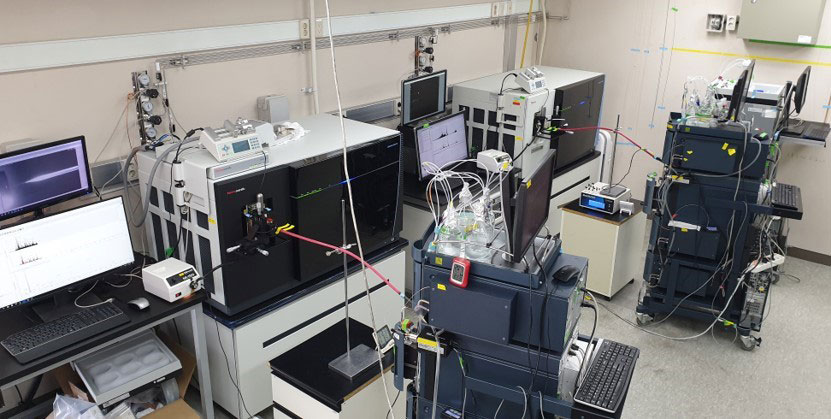Jong-Seo Kim
1. High-resolution mapping of RNA-protein interactions
RNA-binding proteins (RBPs) are integral players in post-transcriptional gene regulation, affecting every step of RNA metabolism. Mass spectrometry (MS)-based proteomics has been used to elucidate the RNA-interactome in various biological systems. However, the profiling resolution of RNA-binding sites or domains had long been poor and vague stage. To overcome the existing limitations in MS based RNA interactome mapping, the proteomics team focused their efforts on the method development for high-resolution mapping of RNA-protein interactions even at a single amino acid resolution, reporting a couple of representative methods.
Proteomic method development
RBS-ID (NSMB, 2020), pRBS-ID (Nature Comm, 2021), which implement chemical treatment (hydrofluoric acid, HF) to completely digest the UV-crosslinked RNA adduct to a single ribonucleoside (uridine and 4-thiouridine/6-thioguanosine, respectively). The single ribonucleoside adduct minimized MS/MS search space, thereby drastically improving the RBS identification rate. This approach using chemical cleavage instead of enzymatic digestion enabled us to reliably pinpoint individual amino acids as RBSs, providing a single amino acid-resolution.
Comprehensive database of RBSs
We are applying the RBS-ID experiment to various cell line samples from different tissue origins at diverse cellular context or stress conditions in order to generate the most comprehensive RBSs in as many RBPs as possible. Furthermore, we will perform 6-thioguanosine pRBS-ID to cover guanosine binding RBSs as well. With the large-scale MS datasets of both RBS-ID and pRBS-ID, we plan to construct the most comprehensive RBS database (RBS-atlas) for public use.
Development of RNA to protein photocrosslinker
We actively pursuing to develop new chemical tools to expand nucleobase coverage in RNA-protein interactomics, since currently only uridine is the near exclusive crosslinking base. Various types of photocrosslinkers are being synthesized to target other nucleobases such as adenosine and cytidine.
2. Ultrasensitive and super-resolution proximity labeling proteomics
Mapping of localized RNA interactome is important to elucidate their roles in the subcellular compartments or membrane-less granules such as p-bodies and stress granules. Because these granules are formed through liquid-liquid phase separation (LLPS), it is not easy to physically purified them without cytosolic proteome interference via conventional methods. Therefore, it has been challenging to investigate the factors governing LLPS and granule formation. We uniquely developed an efficient enrichment protocol of biotinylated peptides for proximity labeling proteomics, enabling ultrasensitive detection of proximity-labeled peptides. Our method unambiguously pinpoints the proximity-labeled sites at single amino acid resolution, thereby ensuring the proximal interaction of the identified proteins with the bait and providing structural information such as topological architecture of membrane proteins at super-resolution compared to conventional proximity proteomics platform.

 Center for RNA Research
Center for RNA Research